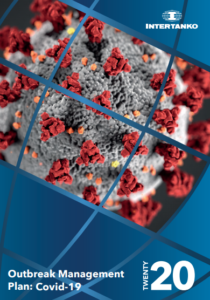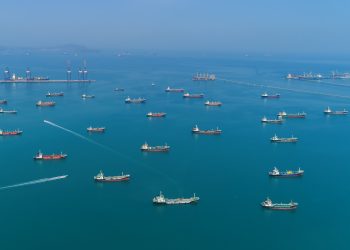INTERTANKO issued an Outbreak Management Plan, outlining plans and procedures to be put in place to prepare a ship for shore personnel to come onboard and to protect seafarers from the dangers of COVID-19. This includes potential exposure from shore personnel and the actions to take in the event of a suspected case onboard.
Basic protective measures against COVID-19
The following advice is in line with WHO general advice and based upon the ICS guidance:
- Frequent hand washing by crew using soap and hot water or alcohol-based (at least 65-70%) hand rub for 20 seconds;
- Avoidance of touching the face including mouth, nose and eyes with unwashed hands (in case hands have touched surfaces contaminated with the virus);
- Seafarers should be encouraged to cover their nose and mouth with a disposable tissue when sneezing, coughing, wiping and blowing the nose, then dispose of the used tissue immediately;
- If a tissue is not available, crew should cover their nose and mouth and cough or sneeze into a bent elbow;
- All used tissues should be disposed of promptly into a waste bin;
- Seafarers should aim to maintain social distancing and keep at least one metre (3 feet) distance from other people, particularly those that cough or sneeze or may have a fever. If they are too close, other crew members can potentially breathe in the virus; and
- Meat, milk or animal products should always be handled with care, to avoid cross-contamination with uncooked foods, consistent with good food safety practices.
- The consumption of raw or undercooked animal products should be avoided.
- A medical log should be maintained.
When In Port
When entering ports of an affected country, seafarers must refrain from going ashore, with any disembarkation from the vessel avoided where possible.
Furthermore, during the port stay there should be minimal interpersonal exchanges with persons from ashore, avoiding contact with people who show symptoms of flu or high temperature and taking care of personal hygiene, including more frequent handwashing, etc. The primary means to prevent transmission of the virus is to maintain social distancing.
Encourage the terminal to use all available electronic and radio controlled devices (Phone, VHF, E-mail) for ship-shore interface.
Key points are:
- Ship’s staff exposure on main deck must maintain social distancing. PPE to be worn as required. Care should be taken that the PPE in use must also comply with that needed for the handling of the cargo.
- If any shore person exhibits a fever or flu-like symptoms then they need to depart the vessel at the earliest possible time.
Crew to frequently clean hands by using alcohol-based hand rub or soap and water.
Gangway watch shall have to take remote temperature gauging of those coming on board (using a noncontact thermometer) and should not allow entry if the readings are above 37.3 degrees Celsius.
Generally thermometers in the hospital on board are of probe type. Every company should make all effort to provide non-contact thermometers for this purpose.
Where a clinical non-contact thermometers are of non-intrinsically safe type, those boarding should be escorted to a safe area where their temperature may be monitored.
According to the WHO, scanning for temperature is not 100% effective as some infected people show no symptoms initially and some do not develop symptoms for up to 10 days. In general:
- No handshaking or any physical contact.
- No shore personnel should enter internal spaces of the vessel and accommodation doors should be locked.
- In the event that shore personnel do need to enter the accommodation, then they should be escorted throughout, maintain social distancing and wash their hands frequently.
- Have available at the gangway sanitising and disinfectant material for shore personnel when boarding.
- Food must not be brought on board by shore personnel. Shore personnel should not, where possible, eat on board.
- Have a dedicated space and /or toilet for the use of shore personnel, which should be cleaned and disinfected afterwards upon vessel departure.
- Shore embarkation ladders/gangways: It is recommended that no crew member should come in direct contact with any shore equipment including shore gangways and ladders.
Precautions with Pilot onboard
In the hour prior to Pilot boarding, wipe down the entire bridge with a 5% solution of bleach in water (Chart table, instruments, chairs, helm, entire console, windows, etc).
The cleaning should be repeated after the departure of the Pilot. Have disposable gloves readily available in order to supply the Pilot (if required) after his embarkation, which he should wear until his disembarkation.
Remote temperature gauging of the Pilot (using a non-contact thermometer) should be undertaken and boarding should not be allowed if the readings are above 37.3 degrees Celsius.
Handshakes and other physical contact must be avoided. Social distancing between Pilot and bridge personnel should be in place at all times.
Any crew member entering the bridge including the pilot should thoroughly wash their hands prior to entering the bridge. To facilitate this the toilet located next to the bridge should have all necessary sanitizing materials.
Pilots may bring their own sanitizing materials, but these should also be provided by the ship and made available for all bridge team members to use frequently.
Throughout the transit, all personnel on the bridge including the Pilots are encouraged to regularly wipe down any surface and equipment they come into contact with, such as pens/pencils, binoculars, radar control panels, ECDIS control panels, PPUs, VHF radios, chairs, handrails, etc.
If the Pilot is in a non-critical area of navigation and feels that they may need to cough or sneeze then they are encouraged to step to the bridge wing or exterior of the wheelhouse and do so in an open environment away from other individuals.
If the area of navigation or layout of wheelhouse does not permit this action, then the individual shall cover their mouth/nose and orient themselves in a direction away from other individuals.
When safe to do so, they shall proceed with wiping down of the surfaces in their immediate vicinity.
Same applies to all ship’s personnel attending the bridge. Only essential personnel should be allowed in the wheelhouse.
Eating while on the bridge should be prohibited and the Pilot service informed of this prior to their boarding.
Precautions with Private Maritime Security Guards onboard
When engaging the services of a Private Maritime Security Company (PMSC), the company should undertake due diligence and ascertain the steps taken by the PMSC to ensure their guards are free of the virus.
The vessel should follow the same precautions as for Pilots boarding the ship.
However, as the guards will be sailing with the vessel, social distancing and cleanliness will be key.
After the guards have disembarked, their accommodation should be thoroughly cleaned.
The company must inform the PMSC if any seafarer falls ill with a fever, flu-like symptoms or tests positive for Covid-19 within two weeks of the guards’ departure.
Similarly, the PMSC must inform the company if any of the guards fall ill with a fever, flu-like symptoms or test positive for COVID-19 within two weeks of departing the ship.
Explore more herebelow:
































































